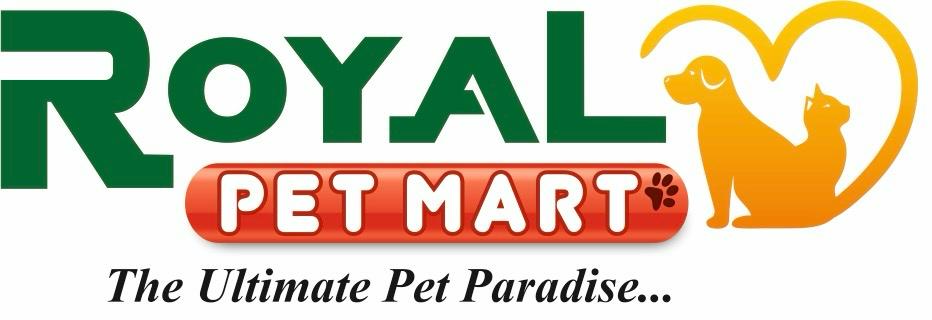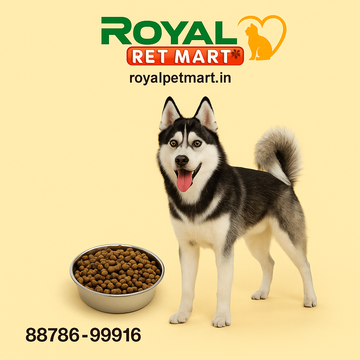Top Solutions for Your Dog’s Skin and Coat Problems
by Royal Pet mart on May 05, 2025

Introduction
I’ll never forget the day I noticed Bella, my sweet golden retriever, scratching herself raw behind her ears. Her once-shiny coat looked dull, and she seemed so uncomfortable—it broke my heart. Over the years, I’ve learned that dog skin and coat problems are something so many pet parents deal with, and they can really take a toll on a dog’s happiness and health. Whether it’s itchiness, flakiness, or patchy fur, these issues can make your pup miserable. After a lot of trial and error, vet visits, and research, I found solutions for dog skin issues that truly worked for Bella. In this blog, I want to share what I learned—the vet-recommended dog skin treatments, products from Royal Pet Mart, and practical tips—so you can help your dog feel their best again.
Common Causes of Dog Skin and Coat Problems
I started looking at general causes of skin and coat issues because when Bella's scratching started I had no idea what might have caused it. It turns out, there are many variables... a lot of possible things that can influence a dog's skin and coat - and Bella had a number of things happening at the same time.
Allergies are one of the most common causes of dog skin issues. In Bella's case, it was fleas, which with the level of scratching and reaction to the flea bites must have been picked up on a walk in the park. Allergies can also be from food (grains, chicken, etc.), or anything in the environment (pollen, dust etc.). There are parasites like fleas, ticks, or mites that cause irritation, but also open the door for skin infection, and probably more than a couple of different parasites. And infections, dog skin infections, fungal, and bacterial, can also form particularly during humid conditions. I noticed a yeasty smell on Bella once, and her vet confirmed it was a fungal infection.
Poor nutrition was another issue for us. I used to feed Bella a cheap kibble that lacked the nutrients she needed, and her coat paid the price. Hormonal imbalances, like thyroid problems, can also play a role, though thankfully Bella didn’t have that. Finally, dry air in the winter and excessive grooming (I was bathing her too often!) stripped her skin of natural oils, making things worse. Figuring out these causes was the first step to finding the right solutions for dog skin issues.
Signs Your Dog Might Have a Dog Skin and Coat Problem
At first, I didn’t identify how severe Bella’s coat and skin problems were—I thought she was just scratching a little more than normal. But then I began to notice more signs that something was wrong, and I will tell you what to look for now as well.
Bella’s incessant scratching and itching was the most apparent sign—she would scratch at her belly and ears for hours, sometimes even waking me up at night. I also noticed bald patches or thinning coats around her tail and sides, which concerned me about her dog coat health. Her skin was red, inflamed, or scaly in appearance, especially on her belly, which looked bright pink and scaly. She also had an unusual smell, like a mixture of yeast and dirt instead of her typical dog smell. Excessive shedding became an issue—there were clumps of fur all over the house, well beyond her regular shed. And worst of all, I found scabs or hot spots on her back—raw, irritated patches that looked so sore.
These signs can point to anything from dog skin allergies to infections, so paying attention to them early can help you get ahead of the problem and find the right dog skin itching relief.
Top Solutions for Dog Skin Issues
As soon as I figured out what the issues were with Bella, I was committed to finding ways to solve dog skin issues that would help her feel better. After working directly with her vet and trying a few things at home, here's what made a huge difference.
a. Improve Their Diet for Dog Coat Health
Bella’s vet told me that a good diet is the foundation of dog coat health, and I saw a huge change after I switched up her food. She needed more omega-3 and omega-6 fatty acids, which help reduce inflammation and keep the coat shiny. I started feeding her a salmon-based kibble that was packed with these nutrients, and her coat started looking so much better within a few weeks. High-quality protein sources like chicken or turkey are also key—they help repair skin and encourage hair growth. I also added dog skin supplements like probiotics to support her gut health, which indirectly helped her skin. I found some great omega-rich foods and probiotics at Royal Pet Mart, and they were a total game-changer for Bella’s dog skin and coat wellness.
b. Use Medicated or Hypoallergenic Shampoos
I used to think bathing Bella more would help her skin, but I was wrong—over-bathing was drying her out. Her vet suggested using a vet-recommended dog skin treatment like a hypoallergenic shampoo, and I picked one up from Royal Pet Mart that was free of harsh chemicals. I now bathe her every 2–3 weeks, just enough to clean her without stripping her natural oils. The shampoo I use has oatmeal in it, which really helps with dog skin itching relief—it calmed her redness and flakiness almost immediately. If your dog has dog skin infections, a medicated shampoo with antifungal ingredients might be better, but always check with your vet first to avoid making things worse.
c. Regular Dog Grooming for Skin Health
I started making dog grooming for skin health a regular part of Bella’s routine, and it’s done wonders for her. I brush her coat 2–3 times a week with a soft-bristle brush I got from Royal Pet Mart—it’s gentle but gets rid of dead hair and skin, keeping her coat healthy. Brushing also spreads her natural oils, which helps with dog coat health, and it stops matting and tangles that can trap dirt and lead to irritation. I love using a dog skin health grooming tool like a de-shedding comb for her heavier shedding seasons—it keeps her coat smooth and lets me check for any new bald patches or thinning coat. Plus, Bella loves the attention, and it’s become a special bonding time for us.
d. Control Dog Skin Allergies
Since Bella’s dog skin allergies were mostly from fleas, I knew I had to get serious about dog flea prevention. I started using a vet-recommended flea treatment from Royal Pet Mart, and it stopped the problem in its tracks—no more fleas means no more allergic reactions for Bella. I also switched her to a grain-free dog food to see if food allergies were part of the issue, and while it didn’t make a huge difference for her, it’s worth trying if your dog might have a food sensitivity. For environmental allergens like pollen, I wipe her paws with a damp cloth after walks to keep irritants off her skin. These steps really helped reduce her need for dog skin itching relief, and she’s been so much more comfortable.
e. Vet Treatments for Dog Skin Issues
Some of Bella’s issues needed more than home care, so we turned to vet treatments for dog skin issues. Her hot spot was not going to resolve itself, and her veterinarian prescribed an antibiotic cream to resolve the bacterial infection and it worked within a few days. I was relieved! She also had a short course of steroids to get the inflammation down from her flea allergy, and it made the scratching stop. If your dog has a persistent dog that is experiencing persistent skin and coat problems, your veterinarian could recommend some blood tests, or even a biopsy, to get to the bottom of their problems, especially if they thought your dog might have a hormonal imbalance. I was happy that I took my veterinarian's advice; it changed everything for Bella.
Natural Remedies for Dog Skin You Can Try at Home
I’m always looking for gentle ways to help Bella, so I tried a few natural remedies for dog skin that I could do at home. These were great for soothing her skin between vet visits, and they’re easy to do with stuff you probably already have.
First, I gave Bella an oatmeal bath—I ground up some plain oatmeal, mixed it with water to make a paste, and let it sit on her itchy spots for about 10 minutes before rinsing. It was amazing for dog skin redness treatment, calming her irritated skin right away. I also started using coconut oil on her coat—just a tiny bit rubbed into her fur added moisture and made her coat so shiny, helping with dog coat health. Another trick I tried was an apple cider vinegar spray—I mixed it with water (1:1 ratio) and sprayed it on her yeasty spots, but you have to be careful not to get it on open wounds, and stop if it seems to bother your dog. Lastly, aloe vera gel (the pure kind, no additives) worked wonders on her hot spots—it’s a natural way to soothe dog skin irritation, and Bella seemed to love the cooling feeling.
These remedies are simple and affordable, but always double-check with your vet to make sure they’re safe for your dog’s specific dog skin and coat problems.
When to See a Vet for Dog Skin Problems
There were moments with Bella when I knew I couldn’t handle her dog skin and coat problems on my own, and I learned when to see a vet for dog skin problems. If your dog’s symptoms don’t get better after a week—like Bella’s hot spot that just wouldn’t heal—it’s time to call the vet. Sudden hair loss or bleeding is another red flag; I noticed Bella losing a lot of fur around her tail once, and it turned out to be a sign of a deeper issue. If your dog seems in pain or shows behavioral changes, like hiding or snapping when you touch them, don’t wait—Bella started avoiding me when I tried to check her skin, and I knew something was wrong. And if natural remedies for dog skin aren’t helping after a few tries, it’s best to get vet-recommended dog skin treatments to figure out what’s really going on.
Conclusion
Helping Bella through her dog skin and coat problems showed me how important it is to act early—catching these issues before they get worse can save your dog a lot of discomfort. From improving her dog coat health diet to using dog grooming for skin health and trying vet treatments for dog skin issues, I found what worked for her, and I hope these tips help your pup too. I got some of the best products for dog skin problems, like shampoos and dog skin supplements, from Royal Pet Mart, and they made such a difference. Keep up with regular vet visits and grooming habits to stay on top of your dog’s dog skin and coat wellness, and remember that every dog is unique—what works for Bella might need tweaking for your furry friend. Here’s to happy, healthy pups with shiny coats and wagging tails!




